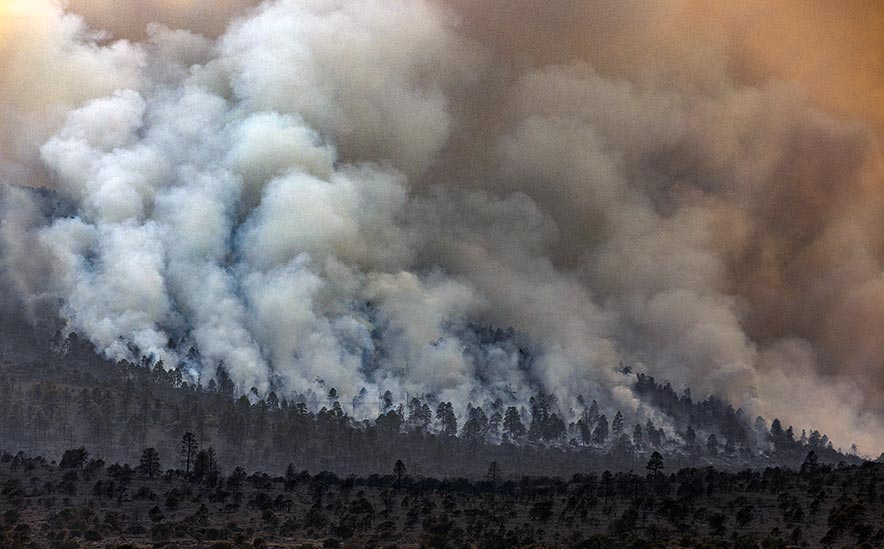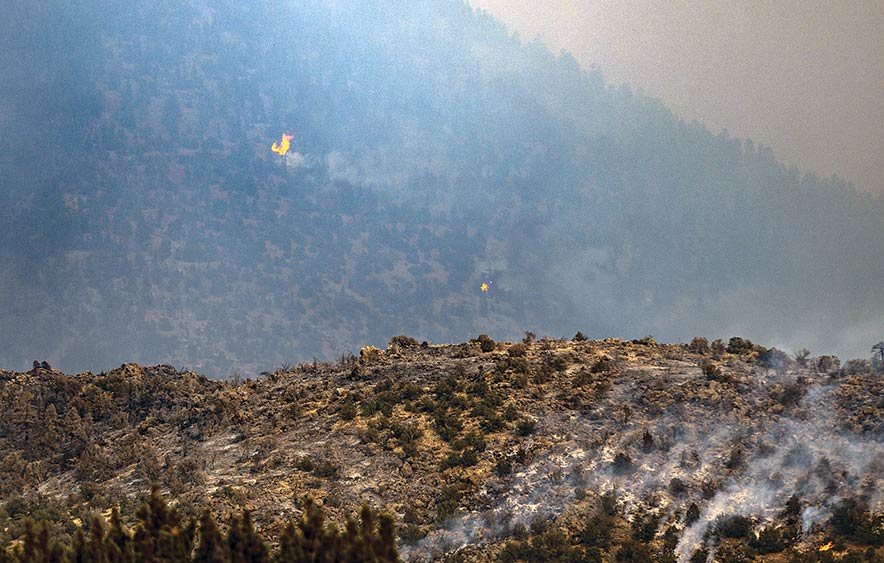
‘Doo Nijich’ąąh da!’: Hataałii say fire is ‘our protector’

Navajo Times | Sharon Chischilly
A cloud of smoke fills the sky from the Pipeline and Haywire fires near Flagstaff on June 15.
KINŁÁNÍ-DOOK’O’OOSŁÍÍD
Hataałii say the ‘ana’í were welcomed within Diné Bikéyah and now they’re assaulting and destroying one of the sacred mountains.
Part of Dook’o’oosłííd – Nuva’tukya’ovi Kiis’áaniik’ehjígo – has burned in the Pipeline Fire, and that means the ‘azee’, ch’il, and the ńdíshchíí’ have burned too.
Still, wildfires are essential to the continued survival of some plant species.
Scientists say wildlife and vegetation have a long-standing relationship with fire in the San Francisco Peaks region because fire is a natural part of these landscapes. In fact, the ecosystem in Lockett Meadow is the result of a big fire around 1879.
While some animals were displaced and others injured or perished in the Pipeline and Haywire fires, many species require fire. But the ecosystem hasn’t evolved with reclaimed wastewater because it remains to be seen what adverse effects will occur.
For decades, medicine people and activists have fought the Arizona Snowbowl’s expansion plans, including clear-cutting acres of forest, disturbing delicate alpine tundra, and artificial snowmaking on the mountain.
They argue that the medicinal herbs have been defiled by the recycled and treated sewage effluent – and the associated pharmaceutical chemicals – that Snowbowl uses to make artificial snow.
The mountain is more than a physical presence: it’s a divine symbol to at least 13 federally recognized tribes in the region.
The hataałii say the tribes are no longer respected, and it’s indisputable that the cultural identity and belief systems of the tribes are damaged by not only the artificial snowmaking but also by the ruinous wildfires near the third sacred mountain.
‘Ana’í
A detention and status hearing occurred last Thursday for Matthew Riser, the man accused of lighting a fire in the Coconino National Forest leading to the Pipeline and Haywire fires.
He was arrested last Sunday after allegedly burning toilet paper at his campsite in the national forest the day before.
According to U.S. Attorney Patrick Schneider’s argument for Riser’s pretrial detention, he had been burning toilet paper approximately 80 yards from where the Pipeline Fire began.
He was seen driving away from the fire, according to a statement of probable cause. He has been charged with using prohibited fire, using the national forest lands as a residence, and possessing marijuana.
While Riser was arrested on a few federal violations, none of which are for causing the fire.
“If it was started by lightning or something else, it would have been a different story,” said hataałii Rita Gilmore from Ch’ínílį.
“No matter how you look at this, we were always told way, way back that non-Diné are perceived as (‘ana’í),” she said. “When the (‘ana’í) starts a fire like that, it’s with real intentions.”
Hataałii say the ‘ana’í may have been unaware the fire would evacuate more than 2,000 households, but it’s logical they wanted to burn the ‘azee’, ch’il, and the ńdíshchíí’.
“They didn’t realize that,” Gilmore said. “This is huge. This was ill-intentioned, and they planned how to do it.”
On Tuesday morning, the Pipeline Fire was about 60% contained at just over 26,500 acres. Like the recent Tunnel Fire, the Pipeline Fire spread rapidly partly because it’s burning intensely, propelled by hot, dry, windy weather conditions and the national forest overpacked with trees.
“We have what’s called a nááhwíiłbįįhí, the gambler,” said hataałii Lorenzo Tyler from Tsé ‘Ałnáozt’i’í, New Mexico. “They (tribe) set up a gambler right next to it – right next to the sacred mountain.
“That’s one of the stories we (Diné) were told a long time ago,” he said.
Tyler said the six sacred mountains serve as boundaries of Diné Bikéyah, but nowadays, na’azhǫǫsh, another ‘ana’í, border Navajoland, outnumbering the mountains.
“It doesn’t look good,” Tyler said. “It’s not how it’s supposed to be. Although (Diné lawmakers) say it’s for economic development, job growth, and whatnot, that shows what Mother Nature is telling us too, that we’re just dying out.
“It’s our home,” he said. “Would you let a stranger come in and do whatever they want and take anything they want from your home, including your language, heritage, teachings, wisdom, and your knowledge? It’s exactly the same thing.”
Tyler said that the forefathers of the tribe have said, baa ‘áhwiilyą́ and not to modernize the Diné culture and traditions.
“Now, we’re trying to find a solution, and there’s no one out there as far as the government saying anything about protecting the people,” Tyler added. “The only solution is going back to our traditional ways, to our prayers and our ceremony.”
Sacred mountain burning

Navajo Times | Sharon Chischilly
Hot spots break out from the Pipeline and Haywire fires burning in the Coconino National Forest near Flagstaff on June 15.
The Pipeline and Haywire fires belched smoke and soot, blanketing those who live downwind with thick, dirty air and hurting wildlife.
Jenny Yazzie Buckinghorse of Kinłichí’í, near Tółchííkooh in Tsiizizii, said smoke shrouded Grand Falls and the southwestern Navajo area like an acrid fog.
The fires themselves are destructive and devastating, said the hataałii.
“It’s just another sign that signifies that (the non-Natives) are extracting and burning our culture and our heritage,” Tyler said.
“When there’s a bad sign, such as the fire, that’s when everybody wakes up and verbalizes, ‘Where’s the medicine man? Where are the medicine people?’” he said.
“But we’re not strong and resilient and strong as we used to be,” he said. “But we’ll always have that fire as our protector.”
Gilmore said when she was a girl, she and her parents and grandparents would often travel to Názlíní and toward Kinłichí’í (Kin Dah Łichí’í) before the highway was built through Burnside Junction, Arizona.
She said there is a hill called Dził Disxǫsí in Názlíní that passersby just didn’t pass and people would offer it tá’dídíín. Those who didn’t have tá’dídíín offered it igneous or metamorphic rocks.
“You’d always tell the hill (Dził Disxǫsí) why you’re passing, what your intentions are and how you want to travel with protection, and that you’ll be able to return home,” Gilmore explained. “It’s like that with these mountains.
“A lot of our people travel,” she said. “They recently traveled to Phoenix, where a lot of graduations took place. I bet not even half of those people who traveled didn’t make their offering to Dook’o’oosłííd.”
Gilmore urges Diné to continue making offerings to the sacred mountains during their travel.
On June 13, Gilmore asked Diné to pray for Dook’o’oosłííd and its ecosystem at 9:10 p.m.
“Due to the spiritual significance of Dook’o’oosłííd, as non-Natives would perceive as ‘a shrine,’ (I) saw the urgency to call for prayers to protect the people, plants, and animals,” she explained.
Gilmore said she prayed with hundreds of Diné in unison.
“As a hataałii, I represent my surroundings, people, and all species,” she added.
Disrespecting Natives
Hataałii say Bilagáana have a long history of disrespecting Natives and denying humanity and fundamental rights. And in some border towns, the discrimination Natives face is often apparent.
They say it’s not surprising that non-Natives might feel empowered to discriminate against and taunt Natives in a community that continues to tolerate the desecration of the Peaks.
Leland Grass, president of the Diné Medicine Men Association Inc., supports Tyler’s and Gilmore’s teachings and knowledge. He says they’re both correct.
“We’ve been carrying these stories from generation to generation, which basically means we’ve been here for a very long time,” Grass explained. “In our stories, it’s how we connect with nature, especially the sacred areas because it seems like everything that we touch today are sacred – coming from nature.
Religion also plays a role, said the hataałii.
The “Doctrine of Discovery,” a framework for how colonizers should interact with Indigenous people in the Americas, was introduced in Johnson v. M’Intosh, an 1823 Supreme Court ruling limiting the land rights of Natives.
Chief Justice John Marshall accepted the doctrine as the basis of U.S. territorial acquisition.
Indigenous people could claim their land, and Bilagáana, the Europeans, could decide how they reacted to those claims, whether with treaty or force.
Marshall explained the Bilagáana claiming land from Natives in the Americas agreed to a sort of “first-come, first-served” approach to avoid war with one another.
Under the doctrine, Europeans could assert “a right to take possession, notwithstanding the occupancy of the (Natives), who were heathens.”
“There are humanities (such as ‘Ana’í) who don’t have those things (culture, traditions, and land),” Grass said. “They wish they had (them), but they don’t.
“So, what they do is intervene and mingle among the sacred people, us, and they take those things and use it elsewhere for money and personal gain,” he said.
The hataałii also talked about preserving Diné language because there are only a few hundred remaining speakers who know it fluently.
“Now they (Bilagáana) use it in society, in modern way of thinking – in their own language, English,” Grass said. “And that doesn’t really help, and it doesn’t work. That’s what’s going on with the mountain.
“They use a man-made law to take care of that mountain, but only for their purposes and interests in the outside world,” he said. “They act like they understand, but they don’t. They just want to take.”
Tyler said there are undoubtedly many opinions as Diné are expressing their views.
“Even our prayers, our sacredness, our jewelry are the same way,” Tyler explained. “Our silversmith has been commercialized, and there aren’t (many) authentic silversmiths anymore.
“Everything is made elsewhere, and now, it’s our ceremonies,” he said. “That’s not the sacredness we used to have. We’re not reverent like we used to be.”
Tyler said Diné teachings include drawing yé’ii, ceremonies, and other sacred things.
“Doo nijich’ąąh da!” Tyler exclaimed. “Don’t decorate it or modernize it! Leave it the way it is!
“Everything’s so convenient (technology) now at the same time,” he said. “It’s made everything where we’re corrupted now. All that has damaging (effects), and it goes back to the Long Walk. We forgot about that. We don’t remember that.”
Tyler added that the only time Diné appear to be aware of culture, tradition, and teachings is when Diné Bikéyah is in trouble and that praying to the Creator, and acknowledging the teachings of Diyin Dine’é, should be a priority and not the last resort.
Katsina, a spirit being
Hopi artist Duane Koyawena of Kinłání painted a Katsina emerging over Nuva’tukya’ovi in 2019, when the Museum Fire, another wildfire that burned the Dry Lake Hills in the San Francisco Peaks recreation area, raged.
He designated the painting with the caption, “Iitah kwatsim övah taayugnwaa, tuswkai nit kii ow tunaatyowugnwaa. Kwak kwaa iitaamuy pahawgnaatötah,” which means “Watching from above, helping to protect the lands and their home. Thank you for all the help.”
Robert Breunig and Karen Enyedy purchased Koyawena’s piece and gifted it to the Museum of Northern Arizona. The piece acknowledges the symbolic relationship between the protectors of the Peaks and helpers who defend life and property.
Koyawena said he painted this piece to illustrate that Katsina, the deities, live on Nuva’tukya’ovi.
“Our kids know that Katsina live up there,” he said. “As a kid, from my own experience, they (Katsina) mean a lot to us even as adults. The worry of their house, where they live, being damaged and burned is a frightening feeling.
“Our kids are very concerned,” he said. “Kids and adults (alike) are the same way. So, I decided to put that up. The Katsina that we pray to that give us spiritual direction and values, they also bring the rain.”
Koyawena said when wildfires burn acres of land – at shockingly fast speeds – near Nuva’tukya’ovi, it not only consumes everything in their paths but also damages the home of the deities.
“The whole concept was these Katsina are going to come and bring the rain and help put out the (Museum Fire),” he explained.
His painting is relevant to the Pipeline and Haywire fires.
“These deities are also known as clouds to us,” Koyawena explained. “We pray that they bring us rain throughout the land, especially at times like this when firefighters are putting their lives on the line to help save a community.
“For us, as Natives, as Hopi, it’s for protecting our sacred mountain,” he said. “That’s what the Katsina brings the rain for, and to nurture the land for our crops. But in this significant moment, it’s for the fire.”
Koyawena said when the Pipeline Fire reached the top of Nuva’tukya’ovi, he and his family became concerned.
“Thinking about my sister, we (family) had to evacuate her from Doney Park, which was put on ‘go’ status,” Koyawena explained. “It put everyone on edge. It was tough and heartbreaking. But at the same time, there was a sense of family coming together.
“Throughout the whole fire, it’s hard for me,” he said. “There’s an emotion of frustration, but overall, our prayers are for the better and that things work out.”








 Highway 264,
Highway 264, I-40, WB @ Winslow
I-40, WB @ Winslow